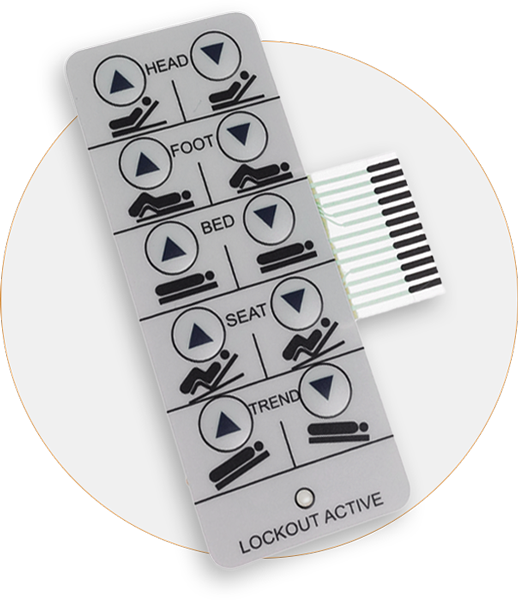Discover Just How a Membrane Switch Improves Resilience and Functionality in Instruments
Discover Just How a Membrane Switch Improves Resilience and Functionality in Instruments
Blog Article
Understanding the Functionality of Membrane Layer Changes for Interface Devices
The functionality of membrane layer switches represents a substantial development in customer interface design, combining effectiveness with visual flexibility. As sectors increasingly prioritize individual experience, recognizing the subtleties of membrane switch modern technology becomes vital.
What Are Membrane Layer Buttons?
Membrane buttons are ingenious user interface gadgets that assist in customer interaction with electronic devices. These flexible components contain several layers, consisting of a visuals overlay, spacer, and a published circuit layer. The design permits a smooth combination into numerous digital tools, enhancing both the visual and functional elements of individual interfaces.
Membrane switches are typically utilized in a wide variety of applications, from family home appliances to commercial machinery and medical devices. Their building and construction commonly includes a slim profile, making them a suitable selection for portable styles. The tactile feedback provided by these buttons can be crafted to meet specific customer choices, making sure efficient communication in between the individual and the tool.
Resilience is another substantial advantage of membrane buttons, as they are resistant to dirt, dampness, and chemicals, which improves their life-span in demanding settings. Additionally, these switches can be customized in regards to shape, size, and visuals design, permitting for branding and user-specific attributes. Generally, membrane changes represent a sensible service for enhancing user experience in digital gadgets, incorporating performance with visual charm in a reliable way.
Exactly How Membrane Layer Switches Over Work
Operating on an uncomplicated principle, membrane layer switches make use of a layered construction to register user input successfully. Each switch includes multiple layers, including a published circuit layer, a spacer layer, and a top visuals layer, which are developed to function together effortlessly. When a customer presses the top layer, it presses the spacer layer, bringing the conductive elements of the circuit layer right into contact with each other.
This call creates a closed circuit, indicating the gadget to implement a particular feature. The layout enables different arrangements, including responsive feedback, which can enhance the individual experience by giving a physical sensation upon activation. The products used in membrane buttons typically consist of flexible substrates, such as polyester or polycarbonate, which make sure durability and resilience against damage.

Key Advantages of Membrane Layer Buttons

Another substantial advantage is their density. Membrane layer switches are slim and lightweight, which enables manufacturers to conserve space in their tools without sacrificing capability. This function is particularly beneficial in applications where weight and quantity are vital considerations.
Furthermore, membrane switches are immune to dust, dampness, and chemicals, improving their resilience. This strength prolongs their life-span and lowers the requirement for frequent substitutes, leading to price financial savings over time.
In addition, the tactile feedback offered by membrane layer switches can be enhanced to improve individual communication. They can include features such as increased buttons or audible clicks, enhancing functionality and user experience.
Applications Across Industries
Interface gadgets using membrane layer buttons article prevail in a broad array of industries, showcasing their versatility and capability. Membrane Switch. In the clinical industry, membrane layer buttons are integral to tools such as diagnostic devices and client surveillance systems, where their toughness and convenience of cleaning are important for maintaining health criteria. In the auto industry, these switches are utilized in control panel controls and infomercial systems, supplying a streamlined and modern-day interface for individuals.
Additionally, the customer electronic devices market gain from membrane layer switches in home appliances and handheld gadgets, where small style and easy to use interfaces enhance user experience. Industrial applications also utilize membrane switches for control board in equipment and automation systems, emphasizing their toughness and resistance to extreme atmospheres.
In the aerospace and defense markets, membrane switches are made use of in cabin controls and devices, where dependability and efficiency under severe problems are vital. Furthermore, the gaming sector significantly integrates membrane buttons in controllers and arcade machines, adding to an appealing individual experience. Overall, the versatility of membrane layer switches over enables their widespread usage across numerous fields, highlighting their importance in modern interface layout.
Future Fads in Membrane Switch Over Modern Technology

In addition, the use of sophisticated products, such as polycarbonate and polyester movies, is anticipated to rise, providing improved resilience and resistance to environmental stress factors. These products add to the overall longevity of membrane switches, making them suitable for harsher industrial applications.
In addition, the incorporation of smart innovation, including IoT connection, will certainly enable membrane switches to interact with other gadgets and systems, assisting in an extra interactive customer experience. This fad straightens with the growing demand for smart devices across various industries, from health care to consumer electronics.
Lastly, personalization choices are expected to broaden, enabling producers to produce bespoke services tailored to particular individual requirements and preferences. These developments will place membrane layer buttons as necessary elements in the advancement discover here of interface modern technology.
Final Thought
In conclusion, membrane layer changes stand for an essential advancement in individual interface modern technology, providing a reliable and flexible remedy for varied electronic applications. As improvements in product science and touch noticing modern technologies continue, the performance and applicability of membrane layer switches are anticipated to increase, reinforcing their relevance in modern-day electronic gadgets.
Report this page